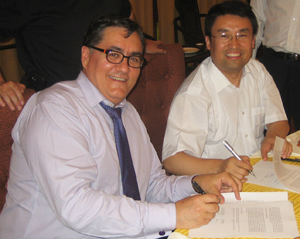Laboratory signs agreement with China to develop clean energy technology
 (Download Image)
LLNL Deputy Director of S&T Tomas Diaz de la Rubia and Dr. Xu Shisen, president of the Clean Energy Research Institute and chief engineer for Huaneng in China, sign an agreement to jointly develop clean energy technologies.
(Download Image)
LLNL Deputy Director of S&T Tomas Diaz de la Rubia and Dr. Xu Shisen, president of the Clean Energy Research Institute and chief engineer for Huaneng in China, sign an agreement to jointly develop clean energy technologies.
The Clean Energy Research Institute was formed by Huaneng Power International Inc., the largest power company in the world.
Under the memorandum of understanding, the Laboratory will create a stronger relationship with Huaneng and both parties will conduct research analysis and data exchange as established under the U.S.-China Clean Energy Research Center (CERC) that was set up last year.
The two parties will exchange information and technology on carbon capture and sequestration (CCS), enhanced oil recovery, shale gas and power engineering.
Specifically, the Lab brings expertise in CCS, advanced material science, engineering and design and energy systems analysis.
"We plan to work on applied scientific challenges in large-scale projects and deployments. We look forward to working closely with our Chinese counterparts to find opportunities to collaborate that serve the needs of both nations," said Julio Friedmann, LLNL's director of the carbon management program.
The Laboratory has a strong relationship with the Chinese through the CERC, a project that facilitates joint research and development of clean energy technologies including CCS by the United States and China.
CCS is a process that separates and captures carbon dioxide (CO2) from industrial and power plant flue streams, then compresses the gas and stores it underground in deep geological formations. The process prevents greenhouse gas emissions from entering the atmosphere. Under normal conditions, greenhouse gas emissions contribute to global warming and climate change.
Huaneng is a big player in CCS by operating GreenGen, the first large-scale coal-fueled power plant to employ integrated CCS. In addition, the company has operated the world's largest CCS pilot at the Shanghai Shidongkou Coal Power Plant, which uses about 15 megawatts of energy to capture 120,000 tons of carbon dioxide (CO2) per year. Friedmann said Huaneng plans to scale up to produce 600 megawatts of energy and sequester up to 2.5 million tons of CO2 per year.
Livermore has a long history in CCS technology by blending computer science, geology, ecology, atmospheric science and other disciplines to find solutions to a number of challenges facing the development and safe operation of carbon capture and storage (CCS) facilities. Areas that Livermore specializes in are: development of novel CO2 capture technologies and processes; evaluating strategies for the co-production of water; predicting the consequences of releases of CO2; simulating subsurface pressure build-up; modeling reactive transport of CO2 in groundwater; monitoring CO2 plumes in subsurface; and characterizing and assessing subsurface geology.
Contact
Anne M Stark[email protected]
925-422-9799
Related Links
LLNL part of U.S. centers for U.S.-China clean energy researchLLNL assisting China in efforts to curb global warming
China Huaneng Group
A Roadmap for U.S.-China Collaboration on Carbon Capture and Sequestration
Related Files
DownloadTags
EngineeringHPC, Simulation, and Data Science
Computing
HPC Innovation Center
Energy
Science
Featured Articles







